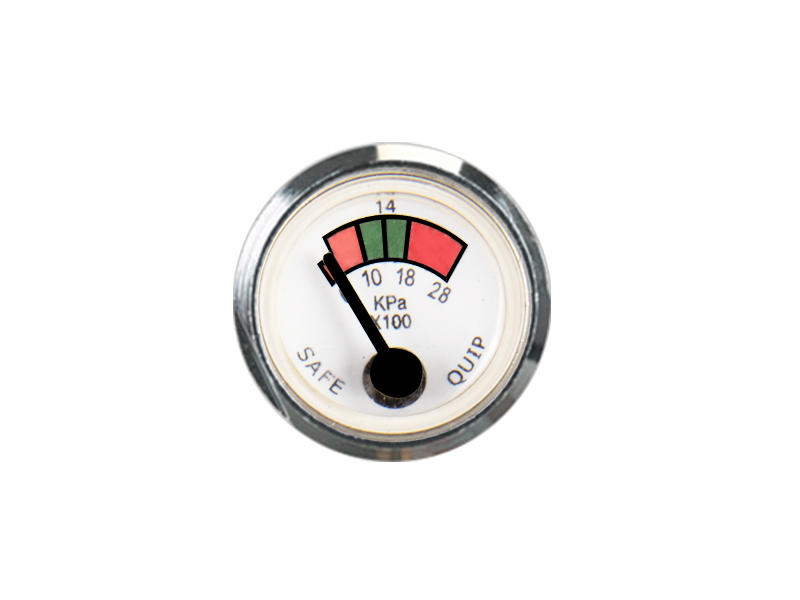⑴ Selection of precision pressure gauge The selection o […]
⑴ Selection of precision pressure gauge
The selection of the pressure gauge should be based on the pressure measurement requirements of the process and production process, combined with other aspects of the situation, to be comprehensive consideration and specific analysis, generally consider the following issues.
① Selection of instrument type The selection of instrument type must meet the requirements of process production, and comprehensively consider the physical and chemical properties of the measured medium and the on-site environmental conditions. For example, whether remote transmission, recording and alarm are required, special media (such as corrosiveness, high and low temperature, high viscosity, dirt degree, flammable and explosive performance, etc.), installation location (such as electromagnetic field, vibration, site conditions, etc.) Special requirements. In short, the correct selection of the instrument type is an important prerequisite for ensuring the normal operation of the instrument and safe production.
For example, for the spring tube of an ordinary pressure gauge, when the pressure p≥19.6MPa, alloy steel or stainless steel is often used; when the pressure p≤19.6MPa, phosphor bronze or brass can be selected. The type of fluid measured is different, and the material of the spring tube used is also different. For example, the spring tube of the ammonia pressure gauge is made of stainless steel, and copper alloy is not allowed. Because ammonia gas is extremely corrosive to copper, it is easy to be damaged when using ordinary pressure gauges.
In order to ensure that the connection is tight and leak-proof, a gasket should be installed according to the characteristics of the pressure and the nature of the medium during installation. However, when measuring oxygen, it is strictly forbidden to stain the gasket with grease or use organic compound gaskets to avoid explosion; when measuring acetylene, it is prohibited to use copper gaskets.
②Determination of the measuring range The measuring range of the pressure gauge should be determined according to the measured pressure during production. When performing pressure measurement, in order to ensure the measurement degree of the pressure gauge, extend the service life of the gauge, and avoid damage to the elastic element due to excessive force, the upper limit of the pressure gauge should be higher than the maximum pressure value that may occur in the process. According to "Automation Design Technical Regulations", when measuring stable pressure, the normal pressure of the pressure gauge is 1/3~2/3 of the range, and the maximum height cannot exceed 3/4 of the range. When measuring the pulsating pressure, the normal pressure of the pressure gauge is 1/3~1/2 of the range, and the maximum height cannot exceed 2/3 of the range. When measuring high-pressure pressure, the maximum normal pressure of the pressure gauge cannot exceed 3/5 of the range.
After calculating the upper and lower limits of the pressure gauge according to the maximum and minimum values of the measured pressure, this value cannot be used as the measuring range of the pressure gauge. Only rounding is performed in accordance with the standards established by the competent authority, and the numerical value in the series value is selected as the range of the pressure gauge.
③The selection of accuracy level is determined according to the maximum measurement error allowed in process production. In the case of meeting production requirements, use pressure gauges with lower precision, low price and durability as much as possible.
Definition of pressure gauge: The concept of pressure here actually refers to the pressure in physics, that is, the size of the pressure per unit area.
1. Pressure: The pressure is higher than the pressure zero position based on the pressure zero position.
2. Positive pressure: The pressure is higher than atmospheric pressure based on atmospheric pressure.
3. Negative pressure (vacuum): The pressure is lower than atmospheric pressure based on atmospheric pressure.
4. Differential pressure: the difference between two pressures.
5. Gauge pressure: based on atmospheric pressure, a pressure greater or less than atmospheric pressure.
6. Precision pressure gauge: based on atmospheric pressure, it is used to measure gauges that are less than or greater than atmospheric pressure.
Precision pressure gauges: In the process of industrial process control and technical measurement, mechanical pressure gauges are more and more widely used due to their high mechanical strength and convenient production due to their elastic sensitive components. The elastic sensitive element in the mechanical pressure gauge undergoes elastic deformation as the pressure changes. Mechanical pressure gauges use sensitive components such as spring tubes (Bourdon tubes), diaphragms, bellows and bellows, and are classified according to this. The measured pressure is generally regarded as relative pressure. Generally, the relative point is selected as atmospheric pressure. The elastic deformation of the elastic element under the action of the medium pressure is amplified by the gear transmission mechanism of the pressure gauge, and the pressure gauge will display the relative value (high or low) relative to the atmospheric pressure.
